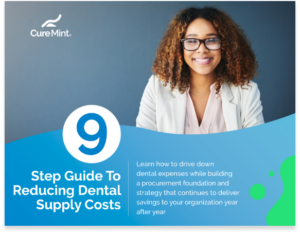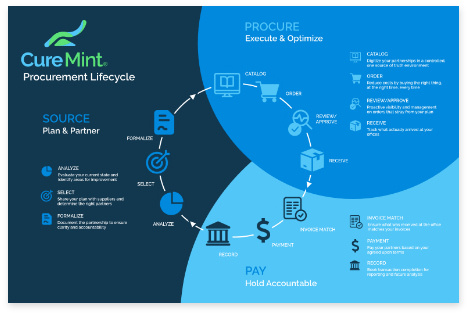At CureMint, we’re committed to driving down costs as we help your dental organization reshape its supply procurement strategy. In this blog series, we’ll guide you through nine easy steps to drive down your dental supply expenses so you can better manage your finances and become more profitable in the dental industry.
Well, friends — we’re friends by this point, right? — we’ve been through a lottogether. Remember when you were so intimidated by the prospect of negotiating with vendors for better prices on your dental supplies? You were so green then. Now, you’re a seasoned veteran. You’ve seen it all.
So you’re evermore prepared to do it all again.

Continued vigilance on angling for the best deals is the best and arguably only way you’ll continue saving on supply costs for your dental organization. We know it’s a relatively simple yet involved process, but the time and effort spent in the undertaking yields a high return on investment.
STEP NINE: RINSE & REPEAT
As a handy reminder, here’s a recap of what exactly those first steps entail.
- Step 1: Organize & Formulize
Collect the last 12 months of your supply spend into a spreadsheet. Request your order history from your primary dental-supply distributors and suppliers, then organize them by relevant product information (name, manufacturer, SKU, price, etc.) to create your starter formulary. - Step 2: Request for Quotation (RFQ)
Send your RFQs to all the major distributors in the dental industry and smaller local suppliers you might like to work with in the future. Once all your RFQs have returned, enter that data alongside your starter formulary. - Step 3: Start Negotiations
Calculate price-per-each for every product, focusing on one category at a time. Formally reach out to your top choice of vendors with a courteous but direct message about lowering prices. Then, contact your other partners and see how competitively they can price their products. - Step 4: Review All the Data
Enter results of negotiations into your master spreadsheet. Compare the best deals and lowest prices with the side perks and other services offered by all vendors. - Step 5: Conduct Clinical Evaluation Trials
Recruit a Clinical Evaluation Team (CET) from your dental offices’ organizational leaders in the clinical staff. Obtain samples of products in consideration for consolidation, then ask your CET to review each product with a simple rating system. - Step 6: Evaluate Trial Results
After collecting results from CETs, calculate each product’s average score. If a product’s trial scores cross your threshold, you should keep them in mind for consolidation into your primary formulary. - Step 7: Finalize Supply Consolidation
Isolate winners of clinical evaluation trials and keep them on your Primary Formulary while moving other products to your Secondary Formulary. Then, communicate often with your clinical staff about any upcoming changes to your office supply lists. - Step 8: Track & Manage Compliance with CureMint
Set systems to encourage formulary compliance with the aim of maintaining savings on supply costs. See how each office in your dental organization spends its supply budget with CureMint, procurement-system software specifically designed for the dental industry. - Step 9: Rinse & Repeat
Whoa, this is getting meta.
If you want to maximize your supply savings, continue the nine steps for every category and subcategory within your formulary. Depending on your number of locations, size of your formulary, and participating CET members, this consolidation should take you anywhere from 6-18 months to complete — no rest for the weary!
Indeed, this nine-step process is meant to be repeated year after year. Products, distributors, and manufacturers change every year, if not every month. This requires your organization to continually stay on top of the changing dental supply chain market. Whether it’s new products entering the market or old manufacturers looking for better market share, by following the steps we’ve outlined in this blog series, you’ll always be able to extract the absolute highest value from your supply expenses.
Related Blogs
Dental Procurement vs. Dental Supply Purchasing: What’s the Difference?
11.02.21
As dental practice owners and office managers look into their…
How to Get Started with Dental Spend Management When You Don’t Know Where to Start
09.30.21
For rapidly growing dental service organizations (DSOs), the…
Using Big Data to Lower Dental Supply Costs
09.28.21
As the dental market surpasses $150 billion and private…





